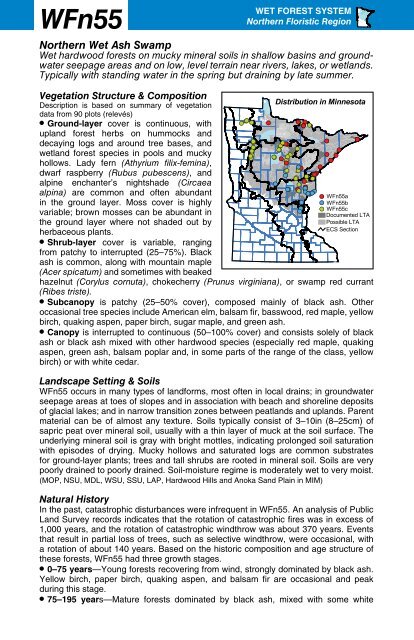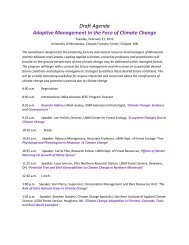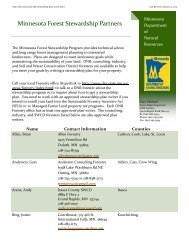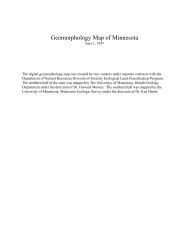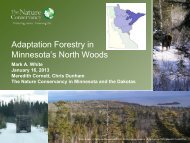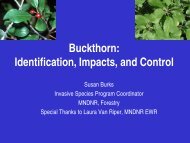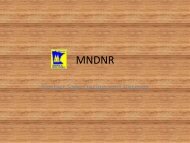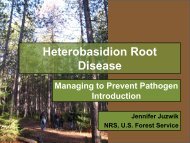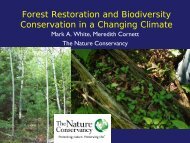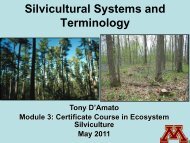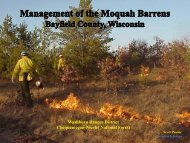WFn55 Northern Wet Ash Swamp factsheet
WFn55 Northern Wet Ash Swamp factsheet
WFn55 Northern Wet Ash Swamp factsheet
Create successful ePaper yourself
Turn your PDF publications into a flip-book with our unique Google optimized e-Paper software.
<strong>WFn55</strong><br />
<strong>Northern</strong> <strong>Wet</strong> <strong>Ash</strong> <strong>Swamp</strong><br />
<strong>Wet</strong> hardwood forests on mucky mineral soils in shallow basins and groundwater<br />
seepage areas and on low, level terrain near rivers, lakes, or wetlands.<br />
Typically with standing water in the spring but draining by late summer.<br />
Vegetation Structure & Composition<br />
Description is based on summary of vegetation<br />
data from 90 plots (relevés)<br />
• Ground-layer cover is continuous, with<br />
upland forest herbs on hummocks and<br />
decaying logs and around tree bases, and<br />
wetland forest species in pools and mucky<br />
hollows. Lady fern (Athyrium filix-femina),<br />
dwarf raspberry (Rubus pubescens), and<br />
alpine enchanter’s nightshade (Circaea<br />
alpina) are common and often abundant<br />
in the ground layer. Moss cover is highly<br />
variable; brown mosses can be abundant in<br />
the ground layer where not shaded out by<br />
herbaceous plants.<br />
• Shrub-layer cover is variable, ranging<br />
from patchy to interrupted (25–75%). Black<br />
ash is common, along with mountain maple<br />
(Acer spicatum) and sometimes with beaked<br />
hazelnut (Corylus cornuta), chokecherry (Prunus virginiana), or swamp red currant<br />
(Ribes triste).<br />
• Subcanopy is patchy (25–50% cover), composed mainly of black ash. Other<br />
occasional tree species include American elm, balsam fir, basswood, red maple, yellow<br />
birch, quaking aspen, paper birch, sugar maple, and green ash.<br />
• Canopy is interrupted to continuous (50–100% cover) and consists solely of black<br />
ash or black ash mixed with other hardwood species (especially red maple, quaking<br />
aspen, green ash, balsam poplar and, in some parts of the range of the class, yellow<br />
birch) or with white cedar.<br />
Landscape Setting & Soils<br />
<strong>WFn55</strong> occurs in many types of landforms, most often in local drains; in groundwater<br />
seepage areas at toes of slopes and in association with beach and shoreline deposits<br />
of glacial lakes; and in narrow transition zones between peatlands and uplands. Parent<br />
material can be of almost any texture. Soils typically consist of 3–10in (8–25cm) of<br />
sapric peat over mineral soil, usually with a thin layer of muck at the soil surface. The<br />
underlying mineral soil is gray with bright mottles, indicating prolonged soil saturation<br />
with episodes of drying. Mucky hollows and saturated logs are common substrates<br />
for ground-layer plants; trees and tall shrubs are rooted in mineral soil. Soils are very<br />
poorly drained to poorly drained. Soil-moisture regime is moderately wet to very moist.<br />
(MOP, NSU, MDL, WSU, SSU, LAP, Hardwood Hills and Anoka Sand Plain in MIM)<br />
Natural History<br />
In the past, catastrophic disturbances were infrequent in <strong>WFn55</strong>. An analysis of Public<br />
Land Survey records indicates that the rotation of catastrophic fires was in excess of<br />
1,000 years, and the rotation of catastrophic windthrow was about 370 years. Events<br />
that result in partial loss of trees, such as selective windthrow, were occasional, with<br />
a rotation of about 140 years. Based on the historic composition and age structure of<br />
these forests, <strong>WFn55</strong> had three growth stages.<br />
• 0–75 years—Young forests recovering from wind, strongly dominated by black ash.<br />
Yellow birch, paper birch, quaking aspen, and balsam fir are occasional and peak<br />
during this stage.<br />
• 75–195 years—Mature forests dominated by black ash, mixed with some white<br />
161<br />
WET FOREST SYSTEM<br />
<strong>Northern</strong> Floristic Region
<strong>WFn55</strong><br />
- continued -<br />
cedar, tamarack, and white spruce and less yellow and paper birch. Quaking aspen<br />
and balsam fir are rare.<br />
• > 195 years—Very old forests similar to mature forests but with more tamarack, white<br />
spruce, and white cedar. Young balsam fir are occasional in the understory.<br />
Similar Native Plant Community Classes<br />
• WFn64 <strong>Northern</strong> Very <strong>Wet</strong> <strong>Ash</strong> <strong>Swamp</strong><br />
WFn64, like <strong>WFn55</strong>, usually is dominated by black ash. WFn64, however, is more likely<br />
to have conifers such as white cedar, balsam fir, or tamarack in the canopy or understory<br />
and abundant wetland grasses and sedges in the ground layer. <strong>WFn55</strong> is more likely<br />
to have mesic forest trees such as sugar maple, basswood, green ash, quaking aspen,<br />
and balsam poplar in the canopy or understory, and mesic forest herbs in the ground<br />
layer. Pools and standing water are common and persistent over the summer in WFn64<br />
but are usually absent by late summer in <strong>WFn55</strong>.<br />
<strong>WFn55</strong> Indicator Species<br />
(freq%)<br />
<strong>WFn55</strong> WFn64<br />
Large-flowered bellwort (Uvularia grandiflora) 18 1<br />
Rugulose or Yellow violet* 27 2<br />
Clayton’s sweet cicely (Osmorhiza claytonii) 51 6<br />
Maryland black snakeroot (Sanicula marilandica) 32 7<br />
Rose twistedstalk (Streptopus roseus) 43 10<br />
Red baneberry (Actaea rubra) 39 9<br />
Wild ginger (Asarum canadense) 56 13<br />
Zigzag goldenrod (Solidago flexicaulis) 20 5<br />
WET FOREST SYSTEM<br />
<strong>Northern</strong> Floristic Region<br />
WFn64 Indicator Species<br />
(freq%)<br />
<strong>WFn55</strong> WFn64<br />
Three-leaved false Solomon’s seal** 1 19<br />
Clearweed (Pilea spp.) 3 21<br />
Water horsetail (Equisetum fluviatile) 3 20<br />
Bristle-stalked sedge (Carex leptalea) 9 48<br />
White turtlehead (Chelone glabra) 4 23<br />
<strong>Northern</strong> marsh fern (Thelypteris palustris) 7 33<br />
Tufted loosestrife (Lysimachia thyrsiflora) 8 31<br />
Spotted Joe pye weed (Eupatorium maculatum) 13 40<br />
*Rugolose or Yellow violet (Viola canadensis or V. pubescens) **Three-leaved false Solomon’s seal (Smilacina trifolia)<br />
• MHn46 <strong>Northern</strong> <strong>Wet</strong>-Mesic Hardwood Forest<br />
MHn46 is similar to <strong>WFn55</strong> mainly when MHn46 has abundant black ash in the tree<br />
canopy or has embedded slight, shallow depressions. MHn46 and <strong>WFn55</strong> often grade<br />
into one another or occur within one another as inclusions on level, gently-sloping<br />
landforms. Pools and standing water are uncommon in MHn46, although soils are often<br />
saturated in the spring. Pools and standing water are typically present in <strong>WFn55</strong> in<br />
spring, and <strong>WFn55</strong> is more likely to support wetland species in the ground layer.<br />
<strong>WFn55</strong> Indicator Species<br />
(freq%)<br />
<strong>WFn55</strong> MHn46<br />
Rough bedstraw (Galium asprellum) 28 1<br />
Red-stemmed aster (Aster puniceus) 34 3<br />
Fowl manna grass (Glyceria striata) 51 6<br />
Mad dog skullcap (Scutellaria lateriflora) 32 4<br />
<strong>Swamp</strong> thistle (Cirsium muticum) 27 4<br />
<strong>Northern</strong> bugleweed (Lycopus uniflorus) 37 7<br />
Common marsh marigold (Caltha palustris) 37 10<br />
Speckled alder (Alnus incana) 34 10<br />
MHn46 Indicator Species<br />
(freq%)<br />
<strong>WFn55</strong> MHn46<br />
Round-lobed hepatica (Anemone americana) 2 39<br />
Pennsylvania sedge (Carex pensylvanica) 9 67<br />
Bracken (Pteridium aquilinum) 6 38<br />
Mountain rice grass (Oryzopsis asperifolia) 8 47<br />
Sugar maple (C) 4 25<br />
Bur oak (C) 8 35<br />
Ironwood (U) 9 36<br />
Downy arrowwood (Viburnum rafinesquianum) 10 40<br />
Native Plant Community Types in Class<br />
• <strong>WFn55</strong>a Black <strong>Ash</strong> - Aspen - Balsam Poplar <strong>Swamp</strong> (Northeastern)<br />
<strong>Wet</strong>-mesic to wet forests. Typically with black ash and other hardwood species as<br />
canopy dominants, occasionally with minor amounts of white spruce or white cedar.<br />
<strong>WFn55</strong>a includes some poorly drained quaking aspen forests, and most (if not all)<br />
occurrences of <strong>WFn55</strong> in which balsam poplar is dominant in the canopy. Grasses<br />
and sedges are relatively important in the ground layer. Speckled alder (Alnus<br />
incana), red raspberry (Rubus strigosus), and bluejoint (Calamagrostis canadensis)<br />
are more common and abundant in <strong>WFn55</strong>a than in other community types in this<br />
class. When present, quaking aspen, balsam poplar, round-leaved dogwood (Cornus<br />
rugosa), prickly or smooth wild rose (Rosa acicularis or R. blanda), fringed loosestrife<br />
(Lysimachia ciliata), panicled bluebells (Mertensia paniculata), rugulose or yellow violet<br />
(Viola canadensis or V. pubescens), and cow parsnip (Heracleum lanatum) are useful<br />
in differentiating <strong>WFn55</strong>a from the other community types in this class. <strong>WFn55</strong>a occurs<br />
in shallow basins and level to gently sloping groundwater seepage areas. <strong>WFn55</strong>a has<br />
been documented in the NSU, WSU, MDL, and MOP. Description is based on summary of<br />
vegetation data from 30 plots.<br />
162
<strong>WFn55</strong><br />
- continued -<br />
WET FOREST SYSTEM<br />
<strong>Northern</strong> Floristic Region<br />
• <strong>WFn55</strong>b Black <strong>Ash</strong> - Yellow Birch - Red Maple - Basswood <strong>Swamp</strong> (Eastcentral)<br />
<strong>Wet</strong> forests. Canopy is typically dominated by black ash, usually with yellow birch and<br />
often with red maple as canopy codominants. <strong>WFn55</strong>b also includes swamps strongly<br />
dominated by red maple and a few swamps with relatively abundant white cedar,<br />
balsam fir, or white pine. <strong>WFn55</strong>b is distinguished from other community types in the<br />
class by the presence of yellow birch. White pine, black spruce seedlings, cinnamon<br />
fern (Osmunda cinnamomea), goldthread (Coptis trifolia), two-leaved miterwort (Mitella<br />
diphylla), and bristle-stalked sedge (Carex leptalea) are also highly diagnostic when<br />
present. The distribution of <strong>WFn55</strong>b is limited to central and east-central Minnesota<br />
and is centered in the WSU; it has also been documented on the Anoka Sand Plain in<br />
the MIM and in the southern part of the MDL. Description is based on summary of vegetation<br />
data from 21 plots.<br />
• <strong>WFn55</strong>c Black <strong>Ash</strong> - Mountain Maple <strong>Swamp</strong> (<strong>Northern</strong>)<br />
<strong>Wet</strong> forests. Canopy is dominated by black ash, occasionally with small amounts of<br />
American elm, paper birch, basswood, quaking aspen, or green ash and occasionally<br />
with abundant white cedar. When present, tall coneflower (Rudbeckia laciniata), interior<br />
sedge (Carex interior), Philadelphia fleabane (Erigeron philadelphicus), northern<br />
bedstraw (Galium boreale), and northern marsh fern (Thelypteris palustris) help to<br />
distinguish <strong>WFn55</strong>c from other types in the class. <strong>WFn55</strong>c has been documented in<br />
the MDL, LAP, SSU, WSU, the northern part of the MIM, and the western part of the<br />
NSU; it is also likely to occur in the MOP. Description is based on summary of vegetation data<br />
from 39 plots.<br />
Ottertail County, MN<br />
photo by Tim Whitfeld, MN DNR<br />
163
<strong>WFn55</strong><br />
- continued -<br />
WET FOREST SYSTEM<br />
<strong>Northern</strong> Floristic Region<br />
<strong>WFn55</strong> <strong>Northern</strong> <strong>Wet</strong> <strong>Ash</strong> <strong>Swamp</strong> — Species Frequency & Cover<br />
Forbs, Ferns & Fern Allies<br />
Lady fern (Athyrium filix-femina) 90 •••<br />
Dwarf raspberry (Rubus pubescens) 90 •••<br />
Sweet-scented bedstraw (Galium triflorum) 76 •<br />
Touch-me-not (Impatiens spp.) 71 ••<br />
Common strawberry (Fragaria virginiana) 70 Wild sarsaparilla (Aralia nudicaulis) 70 Spinulose shield fern or Glandular wood fern* 67 Canada mayflower (Maianthemum canadense) 62 •<br />
Alpine enchanter’s nightshade (Circaea alpina) 61 ••<br />
Jack-in-the-pulpit (Arisaema triphyllum) 61 Naked miterwort (Mitella nuda) 56 Wild ginger (Asarum canadense) 56 Woodland horsetail (Equisetum sylvaticum) 52 Clayton’s sweet cicely (Osmorhiza claytonii) 51 Side-flowering aster (Aster lateriflorus) 48 Common oak fern (Gymnocarpium dryopteris) 44 •<br />
Rose twistedstalk (Streptopus roseus) 43 •<br />
Starflower (Trientalis borealis) 42 Early meadow-rue (Thalictrum dioicum) 41 Bluebead lily (Clintonia borealis) 40 •<br />
Sensitive fern (Onoclea sensibilis) 40 ••<br />
Red baneberry (Actaea rubra) 39 •<br />
Ostrich fern (Matteuccia struthiopteris) 38 •••<br />
Large-leaved aster (Aster macrophyllus) 38 ••<br />
Nodding trillium (Trillium cernuum) 38 Common marsh marigold (Caltha palustris) 37 Wood anemone (Anemone quinquefolia) 37 <strong>Northern</strong> bugleweed (Lycopus uniflorus) 37 Red-stemmed aster (Aster puniceus) 34 Spotted water hemlock (Cicuta maculata) 34 Flat-topped aster (Aster umbellatus) 33 Meadow horsetail (Equisetum pratense) 29 •<br />
Grasses & Sedges<br />
Graceful sedge (Carex gracillima) 63 ••<br />
* Spinulose shield fern or Glandular wood fern (Dryopteris carthusiana or D. intermedia)<br />
freq% cover freq% cover<br />
Bladder sedge (Carex intumescens) 57 ••<br />
Fowl manna grass (Glyceria striata) 51 •<br />
Long-stalked sedge (Carex pedunculata) 37 ••<br />
Bluejoint (Calamagrostis canadensis) 37 ••<br />
Awl-fruited sedge (Carex stipata) 29 ••<br />
Starry sedge (Carex rosea or C. radiata) 29 Drooping woodreed (Cinna latifolia) 28 •<br />
Woody Vines<br />
Virginia creeper (Parthenocissus spp.) 50 •<br />
Low Shrubs<br />
Red raspberry (Rubus idaeus) 57 ••<br />
Tall Shrubs<br />
Mountain maple (Acer spicatum) 68 •••<br />
Beaked hazelnut (Corylus cornuta) 67 ••<br />
Chokecherry (Prunus virginiana) 52 •<br />
<strong>Swamp</strong> red currant (Ribes triste) 52 •<br />
Poison ivy (Toxicodendron rydbergii) 37 •<br />
Speckled alder (Alnus incana) 34 ••<br />
<strong>Swamp</strong> gooseberry (Ribes hirtellum) 32 •<br />
Trees Canopy Subcanopy Shrub Layer<br />
freq% cover freq% cover freq% cover<br />
Black ash 91 •••• 87 ••• 87 ••<br />
Yellow birch 28 ••• 24 •• 21 Quaking aspen 26 ••• 21 •• 23 Paper birch 26 •• 20 • 13 •<br />
Green ash 22 ••• 18 ••• 24 ••<br />
Basswood 22 •• 28 • 34 Red maple 20 ••• 27 ••• 48 White cedar 18 ••• 9 •• 12 Balsam poplar 16 ••• 13 •• 19 •<br />
American elm 16 •• 39 •• 58 ••<br />
Balsam fir 14 ••• 31 •• 47 Bur oak 8 •• 12 •• 36 Sugar maple - - 20 • 23 •<br />
164


